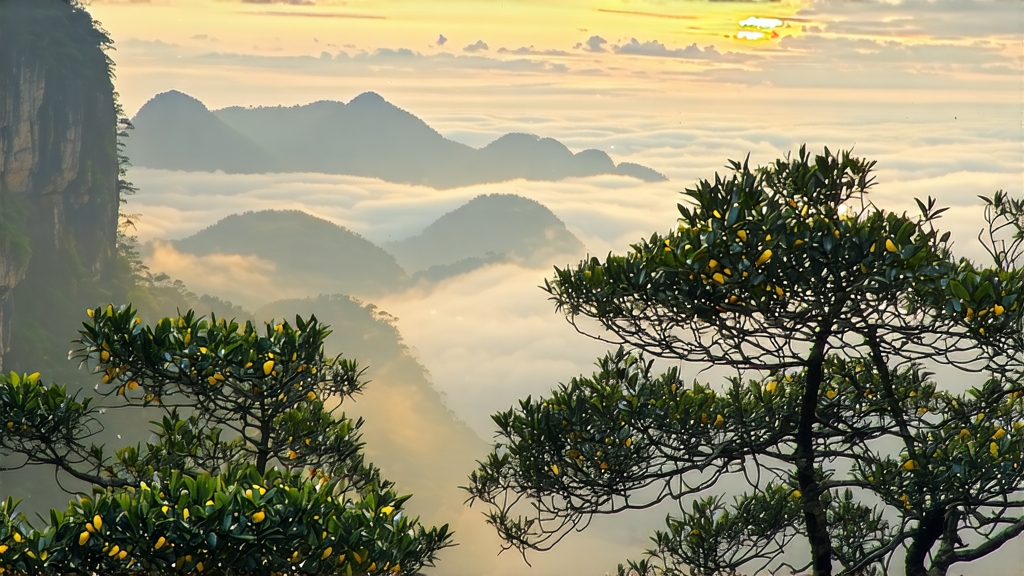
Tucked away in the cloud-veiled peaks of Sichuan’s Ya’an region, Mengding Huangya has been whispering its mellow secrets for more than twelve centuries. To most overseas drinkers “Chinese yellow tea” is a blank page; even seasoned importers rarely stock more than a token kilo. Yet this single bud-and-leaf cultivar, once reserved for Tang-dynasty emperors, embodies the most elusive transformation in all of tea craft—the slow “sealed yellowing” that turns green into gold without ever allowing it to become black. If you have ever wondered what happens when a tea is deliberately kept on the edge of oxidation, inhaling its own floral breath for three humid days and nights, Mengding Huangya is the living answer.
Historical scrolls first record it in 724 CE, when the monk Wu Lizhen planted seven tea bushes on Mengding Mountain as an offering to the dragon kings of rain. By the Song court the buds were pressed into tiny cakes, stamped with the imperial dragon, and carried by horseback to Bianjing along the same stone roads that ferried Tibetan warhorses. When the Ming emperor abolished compressed tribute tea in 1391, the mountain’s monks adapted, mastering the loose-bud style we recognise today. A single 18th-century ledger lists 540 labourers hired solely to wrap each finished ounce in yellow silk, a colour reserved for the emperor. Thus the name Huangya—“yellow sprout”—refers not to the leaf colour but to the fabric that once cradled it.
Botanically the tea belongs to the local Mengding population of Camellia sinensis var. sinensis, a slow-growing strain that endures mountain shade and morning frost. Only the spring fortnight between Qingming and Guyu is judged tender enough; standard pluck is “one bud just unfolding, one leaf still unopened”, 1.8–2.2 cm in length, 0.6 g in weight, downier than Longjing yet sturdier than Silver Needle. A 40-year-old tree yields at most 300 g of finished tea, which explains why even in China authentic Mengding Huangya retails for more than top-grade gyokuro.
The craft begins the moment the basket reaches the cottage door. Sha-qing, the kill-green step familiar from green tea, is deliberately shortened: 70 °C for 90 seconds instead of the usual 200 °C blast. Enough enzymes survive to whisper their chemistry later. While still at 35 % moisture the leaves are hand-tossed in wicker trays for 40 minutes; edges bruise slightly, initiating micro-oxidation. Then comes men-huang, the “sealed yellowing” that gives the category its name. The warm leaf is piled 8 cm deep inside linen bags, which are slid into a pine box lined with wet rice paper. Temperature is held at 32 °C, humidity at 78 %, for 60–72 hours. During this quiet interval chlorophyll degrades into pheophytin, catechins dimerise into theaflavins, and a hay-like note drifts toward apricot. Because the pile is never turned, oxidation is uneven; the outer leaves stay jade, the heart becomes antique gold. Finally the leaf is baked over charcoal at 55 °C for three cycles, each followed by 30 minutes of rest to let residual moisture migrate outward. Total production time: nine days, ten times longer than everyday green tea.
The finished leaf is slim and slightly hooked, the colour of old ivory touched with jade. When stroked it releases a scent that oscillates between fresh corn silk and dried persimmon. Brewed at 80 °C for 45 seconds in a tall glass, the liquor is the clearest honey you will ever taste without viscosity—topaz bright, almost luminous. A second infusion at 75 °C for 30 seconds brings out a cool orchid note; by the third, a faint Sichuan pepper tingle lingers on the tip of the tongue. The after-aroma, what Chinese cuppers call hui-gan, is a sustained chord of sweet alfalfa and steamed chestnut that can last twenty minutes. Because yellowing reduces tannin astringency, the tea forgives almost any clumsy brewer; even five-minute infusions stay smooth, making it an ideal gateway for newcomers who find green tea too grassy or sheng puerh too wild.
Professional tasting follows a quiet